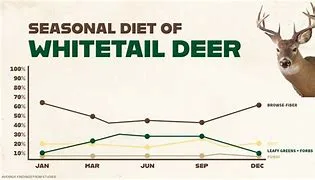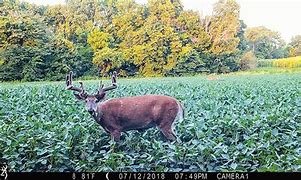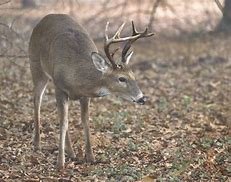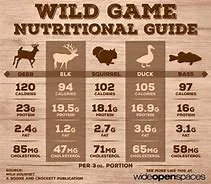
Spring Nutrition for Whitetail Deer

Spring is an invigorating time for whitetail deer, as they emerge from the harsh winter months and begin a period of renewal and growth. With the arrival of warmer weather, deer shed their winter coats and start to seek out fresh food sources to replenish their bodies. The natural landscape bursts into life, offering an abundance of tender greens, budding plants, and new growth that are critical for the Whitetail Deer Nutrition.
During spring, the availability of high-quality forage is crucial for deer. Young plants are packed with essential vitamins and minerals that are vital for their health and development. In particular, the high levels of calcium and phosphorus found in these plants support antler growth in bucks, while the overall nutrient richness aids in the recovery and strengthening of the entire herd. Additionally, these fresh greens are easier to digest and provide the energy needed for daily activities and the upcoming reproductive season.
Monitoring the natural food supply
Monitoring the natural food supply is key to understanding the nutritional needs of whitetail deer during this time. In areas where natural forage is plentiful, deer can largely rely on their surroundings to meet their dietary requirements. However, in regions where the food supply is limited or less diverse, supplemental feeding may be necessary to ensure the herd receives adequate nutrition. This can include providing mineral blocks or protein supplements to bolster their diet and support optimal health.
As deer shift their diet from winter browse to lush spring vegetation, it’s also important to consider the role of water. With increased consumption of fresh greens, their hydration needs naturally rise. Ensuring that clean, accessible water sources are available can help maintain their hydration levels and support their overall wellbeing.
It’s also a period of significant physiological changes, especially for pregnant does who require additional nutrients to support the growth and development of their fawns. Providing a diet rich in protein and minerals can enhance the health of both the mothers and their offspring, leading to a stronger, more resilient herd.
Understanding the seasonal variations in whitetail deer nutrition allows for better management practices and the ability to make informed decisions that benefit the herd. By focusing on their specific needs during spring, we can promote healthy growth, improve antler development, and support the reproductive success of the population.
Summer Feeding Strategies
Summer Feeding Strategies
During the warm summer months, whitetail deer enjoy an abundance of lush vegetation and agricultural crops, which present both opportunities and challenges for their nutrition. These deer, being ruminants, can quickly consume large amounts of biomass and digest it later in a safer environment, which is particularly beneficial during summer when food is plentiful. Access to diverse food sources during this time ensures that deer obtain essential nutrients, such as vitamins A and E, as well as proteins and fats, all of which are crucial for maintaining their health and energy levels.
The summer season is vital for deer to build up the necessary reserves for the harsher seasons ahead. Vitamin A, found in many green plants, plays a significant role in their vision and immune function, while vitamin E is important for muscle development and overall cellular health. Proteins help in muscle growth and repair, which is essential for the physical demands that deer face. Fats, on the other hand, serve as a critical energy source, particularly as they prepare for the breeding season and the leaner months of winter.
Agricultural Areas During Summer – Whitetail Deer Nutrition

Deer are often drawn to agricultural areas during summer, where they can find high-quality forage such as soybeans, corn, and alfalfa. These crops are rich in nutrients and can significantly supplement the deer’s diet. While this can sometimes lead to conflicts with farmers, the nutritional benefits for the deer are undeniable. Implementing strategies to balance the needs of agriculture and wildlife can create a sustainable environment for both.
Maintaining healthy ecosystems
It’s also important to monitor the natural landscape for the availability of native plants that provide a well-rounded diet. Grasses, forbs, and shrubs are part of the deer’s natural diet and should be plentiful during this season. Maintaining healthy ecosystems that support diverse plant life can ensure that deer have access to a wide range of nutrients.
In addition to the rich plant life, summer is also a time when water sources become incredibly important. With increased temperatures, ensuring that deer have access to clean, reliable water is crucial for their hydration and overall health. Water supports their digestive processes and helps in regulating their body temperature.
Managing the land to support both natural and supplemental food sources can enhance the nutritional intake of whitetail deer during summer. Strategic planting of food plots and maintaining natural habitats are effective ways to provide a continuous supply of high-quality forage. Additionally, considering the nutritional needs of specific groups within the herd, such as bucks preparing for the rut or does nursing fawns, can further optimize their health and wellbeing.
By focusing on the diverse nutritional needs of whitetail deer during the summer, we can help ensure that they remain healthy, energetic, and well-prepared for the challenges of the upcoming seasons.
Preparing for Winter in Fall – Whitetail Deer Nutrition

As fall approaches, deer start preparing for the cold months ahead by focusing on building their fat reserves. According to Dr. Dave Hewitt from the Caesar Kleberg Wildlife Research Institute at Texas A&M-Kingsville, deer diets can vary significantly by region and season. For example, northern herds tend to rely more on browse in the winter compared to southern populations. This means that in preparation for winter, deer must build up their fat reserves. A diet rich in protein, fat, and sugar is essential for this process. Supplementing with protein-rich feeds and ensuring access to sugar-rich sources like acorns can help deer accumulate the necessary energy reserves to survive the colder months.
Fall is also a critical time
Fall is also a critical time for bucks, as they recover from the rut and need to regain weight lost during the breeding season. Providing a diet that is high in energy and easily digestible can help bucks restore their physical condition quickly. This may include introducing high-energy supplements such as corn or specially formulated deer feeds that can be scattered in key foraging areas.
As natural food sources begin to dwindle, the importance of mast, like acorns, increases. Acorns are particularly valuable because they are rich in fats and carbohydrates, providing a concentrated energy source that helps deer fatten up before winter. Ensuring that deer have access to acorn-producing oak trees can significantly impact their ability to prepare for the winter months.
Additionally, managing the land to encourage the growth of browse plants can make a big difference. Planting fall food plots with winter-hardy species such as clover, brassicas, and cereal grains can provide a steady food source as natural forage becomes scarcer. These plants are not only nutritious but also resilient to colder temperatures, offering a reliable source of nutrition even as the weather worsens.
Hydration remains important during fall, as deer need to stay hydrated to efficiently metabolize their food and maintain their body functions. Ensuring that water sources are not frozen and remain accessible can help support the deer’s overall health as they transition into winter.
Winter Survival Strategies – Whitetail Deer Nutrition

Winter Survival Strategies
As the cold sets in, whitetail deer face one of the most challenging periods of the year. Natural food sources become scarce, making it crucial to support their diet with high-energy forage and additional fats. Pregnant does are particularly in need of these nutrients to support their developing fawns.
An interesting adaptation that helps deer during winter is their specialized salivary glands. These glands produce enzymes to deactivate secondary plant compounds, such as tannins in acorns, which can disrupt digestion. This unique ability allows them to make better use of the limited food sources available during this harsh season.
Providing strategic supplements is essential to mitigate the limitations of natural resources. High-energy forage like corn can be incredibly beneficial, as it provides the necessary calories to help deer maintain their body weight and stay warm. Additionally, protein-rich feeds can aid in muscle maintenance and overall health.
Acorns
Acorns play a vital role during winter, offering a concentrated energy source rich in fats and carbohydrates. Ensuring that deer have access to areas with acorn-producing oak trees can significantly improve their chances of survival. In regions where acorn availability is low, supplementing with other high-energy nuts or seeds can be a valuable alternative.
Maintaining water sources that do not freeze over is also crucial. Deer need to stay hydrated to metabolize their food efficiently and maintain their body functions. Ensuring that water remains accessible can help support their overall health.
Managing the land to encourage the growth of browse plants that can withstand winter conditions is another effective strategy. Winter-hardy species such as clover, brassicas, and cereal grains can provide a reliable food source even as natural forage becomes limited. These plants are not only nutritious but also resilient to colder temperatures, offering a steady supply of nutrients.
Implementing these strategies can make a significant difference in helping whitetail deer navigate the winter months. By focusing on providing high-energy supplements, maintaining water access, and encouraging the growth of winter-hardy plants, we can support the deer’s health and ensure they have the resources needed to survive the cold season.
Year-Round Whitetail Deer Nutrition Planning

Planning for the nutritional needs of whitetail deer throughout the year requires a comprehensive approach that adapts to the changing seasons. An effective strategy considers the primary components of their diet: browse, forbs, mast, and crops. Understanding these preferences allows us to tailor our management practices to provide consistent nutrition that supports deer health and population sustainability.
In spring, the focus shifts to fresh, young plants that are abundant in essential vitamins and minerals. As discussed, the availability of high-quality forage supports the nutritional needs of the entire herd, including pregnant does and bucks growing new antlers. This period of renewal sets the foundation for the rest of the year, emphasizing the importance of monitoring natural food supplies and considering supplemental feeding if necessary.
Moving into summer, the goal is to take advantage of the lush vegetation and agricultural crops available. During this season, deer can access diverse food sources that provide essential nutrients such as vitamins A and E, proteins, and fats. Strategic land management can help maintain a balance between natural habitats and agricultural areas, ensuring that deer receive the nutrition they need while minimizing conflicts with farmers.
Fall
As fall approaches, Whitetail Deer focus on building fat reserves to prepare for the colder months. High-energy foods and protein-rich supplements are crucial during this time, helping bucks recover from the rut and ensuring that all Whitetail Deer Nutrition can accumulate the necessary energy reserves. The availability of acorns and other mast plays a significant role in providing the concentrated energy sources needed for winter survival.
Winter
Winter presents the most challenging conditions for whitetail deer, making it essential to support their diet with high-energy forage and additional fats. Providing access to corn and other calorie-dense supplements can help deer maintain their body weight and stay warm. Ensuring that water sources remain accessible and managing the land to encourage the growth of winter-hardy browse plants can further support their nutritional needs.
Consistent and thoughtful game management throughout the year is vital for maintaining healthy whitetail deer populations. Annually, the diet of white-tailed deer is primarily composed of browse (46%), followed by forbs (24%), mast (11%), and crops (4%). Understanding these dietary preferences allows for effective year-round nutrition planning. By stocking up on essential nutrients and selecting the right feed options, we can ensure that deer populations thrive across all seasons. The key is to balance their natural dietary habits with strategic supplementation, providing them with a robust and varied diet that supports their health and ensures their sustainability.






















